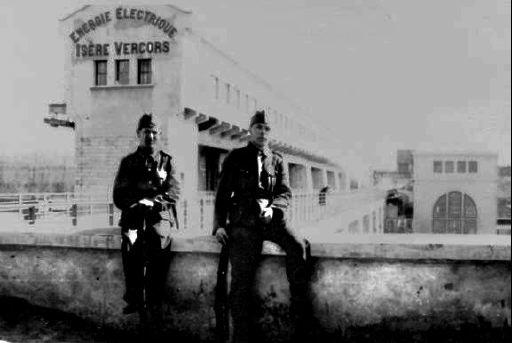
CHATUZANGE-le-GOUBET : PIZANÇON DAM
In June 1940 the fighting took place around this structure, beetween the French army and Wehrmacht,
GEOGRAPHICAL LOCATION
Situated on the left bank of Isère, east of Bourg-de-Péage, four hamlets (Pizançon, Papelissier, Le Goubet and Chatuzange) made up the municipality of Chatuzange-le-Goubet. On the right bank of Isère, stood Romans-sur-Isère.
The Pizançon hydraulic dam, built between 1928 and 1932 across the Isère river, linked the two municipalities of Chatuzange and Romans via a road bridge and a footbridge. The road bridge is now closed to motor traffic and the footbridge no longer exists.
In June 1940 the fighting took place around this structure, the French army being positioned on the left bank (in the municipality of Chatuzange-le-Goubet). Wehrmacht, arrived in Romans-sur-Isère on 22 June.
DEFENCE LAYOUT
In the defence system of the Lower Isère Defence Group (HQ: Valence), Chatuzange-le-Goubet formed part of the defence zone of the group's 2nd Sub-Sector. To its right side stood 1st Sub-Sector of Saint-Nazaire-en-Royans.
2nd Sub-Sector was under command of Colonel Clayette. After the road bridges had been blown up, the pedestrian footbridge at the dam was the last crossing point over the Isère for the French troops still present in the north of the Drôme.
A platoon from 144th Depot,159 Alpine Infantry Regiment (RIA), supported by a 25 mm anti-tank gun, took over defence of the site. A few men from 20 North African Colonial Infantry Regiment (RIC) were positioned on a second line of defence based on the Bourne diversion canal. Officer cadet Rousset, probably from 144 th Depot, was in charge of the whole operation. His unit was reinforced on 23 June by a platoon of Air Force riflemen with light machine guns, who had arrived in the Drôme between 20 and 22 June.
THE WEHRMACHT
On 23 June, elements of 12 Schützen Regiment,(12 Motorized Rifle Regiment, 4 Panzer-Division) appeared in front of the northern end of the road bridge.
Infantrymen were supported by a few tanks. Although a section of the bridge deck was destroyed, possession of the bridge and its intact pedestrian footbridge would enable the Germans to quickly establish a bridgehead over the Isère.
THE FIGHTINGS
Monday 24th June
It was only on 24 June, under pouring rain and protected by artillery fire, that the German riflemen of 12 SR made their first attempt to cross the bridge, an assault that was repulsed at the last minute. But this first attack disrupted Officer cadet Rousset's position. Colonel Clayette ordered Lieutenant de Lestrange, of 146 Regional Battalion, « Mobile Reserve », to take command of Chatuzange troops. His mission was to reorganize the sector by incorporating elements of 144 th Depot, Air Force infantry and colonial infantry around his platoon and the machine guns group he had brought with him.
Upon arriving Lieutenant de Lestrange found the colonial troops sheltering in the two road tunnels of the Pont des Seigneurs (Bourne canal). One of the soldiers had been wounded by shrapnel.
Under constant artillery fire, the troops gained access to the barrage in small groups. Lieutenant de Lestrange reorganized the defence of the site into a two-line strongpoint. Men of 144th depot and elements of colonial infantry were positioned on a stopping line 60 metres in the rear. Facing the openings to the bridge, he posted four rifle-machine guns (FM) while other riflemen from the 146 Regional Regiment took up positions on the upper floors of the turbine building, overlooking the footbridge and bridge.
Consequently, put under French crossfires, the German riflemen of 12 SR withdrew from the northern accesses to the dam to take cover behind. Observing the renewed determination of the defenders of the strongpoint and the effectiveness of their new layout (although they had hoped that the positions would be abandoned), the German command, informed of the imminence of the ceasefire, abandoned any further attempt to cross.
For his action, Lieutenant de Lestrange was mentioned in dispatches by the region commander.
« Lieutenant de Lestrange, of 146 Regional Regiment, tasked with taking command of a strongpoint in delicate circumstances, carried out his mission with the utmost disregard for danger and despite heavy fire, by his designs, finally remained in control of the situation and the ground entrusted to him. »
Glossary :
20th RIC: 20 Colonial Infantry Regiment
146th RR: 146 Regional Regiment
159th RIA: 159 Alpine Infantry Regiment
4th PD: 4th Panzer Division
12th SR: 12 Schützen Regiment (4th PD)
36th PR: 36 Panzer Regiment (4th PD)
BIBLIOGRAPHY
Chazalon, Thierry. Resistances! Les prémices (June 1940 – July 1941), the Resistance began on 23 June 1940 on the banks of the lower Isère valley. Montélimar: autoédition, 2011. 200 p.















